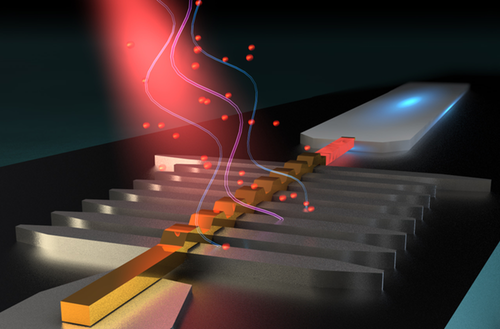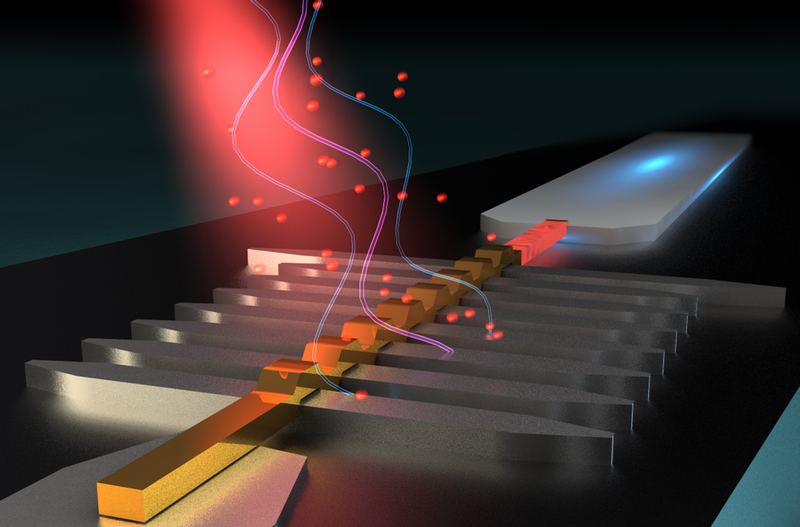Detecting Photons With a Thermometer
Detecting single photons is common practice with visible light, but it has proven much harder to do with lower-energy microwaves. A group of Finnish researchers has now built a small electronic circuit that detects microwave photons based on the heat they produce. In a demonstration, the device detected as few as 200 photons, which is 10 times more sensitive than previous thermally based photodetection techniques.
The main motivation for measuring microwave photons comes from the field of circuit QED, where single microwave photons are corralled in a two-dimensional, metal structure on a microchip. The photons interact through their electric fields with tiny devices called superconducting qubits, which have discrete energy states like atoms for absorbing and emitting photons. These systems offer a unique way to study light-matter interactions and to perform quantum computer simulations. For certain experiments, researchers want a direct count of the number of photons propagating through the system. While microwave detectors are common (in cell phones, for example), they traditionally measure electric field amplitude and therefore can’t give a precise photon count. “We don’t have a way of measuring single photons in the microwave region,” says Joonas Govenius of Aalto University in Finland.
Several strategies are being pursued to detect single microwave photons. A recent experiment succeeded using a superconducting qubit, but that technique requires closely matching the microwave frequency to the qubit [1]. A more widely applicable approach is to use thermal photodetectors, in which incoming photons are absorbed by a thermal mass that exhibits an observable temperature increase.
The thermal photodetector created by Govenius and his colleagues is an electrical circuit that at its core consists of a gold-palladium nanowire intersecting a series of superconducting islands arranged like railroad ties. Conceptually, the circuit can be separated into two pieces: a resistor and a resonator. The resistor is the thermal mass that absorbs the energy from an incoming microwave pulse, and the resonator is a thermometer that registers the heat input through a lowering of its resonant frequency. The team showed that they could read out the circuit’s temperature by using a low-power, “probe” pulse—the amount of probe energy absorbed was proportional to the temperature.
Unfortunately, the temperature spike expected for a weak microwave pulse is too small to detect. To improve sensitivity to the smallest pulses, the researchers used a feedback effect between the probe pulse and the resonator. This effect requires increasing the probe pulse power and tuning its frequency to around 760 MHz, so that it is resonant with the thermometer circuit at relatively high temperatures. When the probe pulse is turned on, it starts to heat the resonator, causing the resonator to absorb more of the probe pulse and heat up even more. As a result of this feedback, the circuit is driven into one of two metastable temperature states.
In this bistable condition, the circuit can be made extremely sensitive to any additional input. If a small microwave pulse arrives when the system is in the lower temperature state, the circuit will be pushed into the higher temperature state. In this case, the device no longer acts like a heat gauge but instead becomes a threshold detector that only triggers in the presence of a sufficiently energetic microwave pulse.
In experimental trials, the team was able to detect the arrival of 8 GHz microwave pulses consisting of 200 photons (the equivalent of 10−21 joules, or 1 zeptojoule) with a signal-to-noise ratio of roughly 1. To improve sensitivity toward the single-photon goal, Govenius says one could switch to a material with a smaller heat capacity, such as graphene. Another option would be to design the system to work at higher frequency, since 200 photons at 8 GHz is equivalent to a single photon at 1.6 THz.
“This is excellent work that is pushing the frontiers of sensitivity for thermal detectors,” says Joel Ullom of the National Institute of Standards and Technology in Boulder, Colorado. Kunihiro Inomata of the RIKEN Center for Emergent Matter Science in Saitama, Japan, agrees that this is a significant advance, but he says it will be challenging to improve the sensitivity of these detectors while also avoiding problems from thermal noise.
This research is published in Physical Review Letters.
Correction (15 July 2016): The text was corrected to clarify that single microwave photons have been detected with other techniques. The caption was also revised to correctly identify the artist’s intensions.
–Michael Schirber
Michael Schirber is a Corresponding Editor for Physics Magazine based in Lyon, France.
References
- K. Inomata, Z. Lin, K. Koshino, W. D. Oliver, J.-S. Tsai, T. Yamamoto, and Y. Nakamura, “Single Microwave-Photon Detector Using an Artificial Λ-Type Three-Level System,” arXiv:1601.05513.





